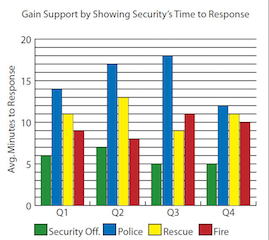Created by George Campbell, Security Executive Council Emeritus Faculty Member

We hear a lot about first responders. In the proactive security organization, our security operations teams are the ones that get the initial emergency call and move to assess it and respond from within. Is your organization up to the test of that call?
We live in risky times, and our facilities require an integrated approach to physical security, life safety and business continuity. The effectiveness of well planned, state-of-the-art technology is lost in low-bid guard force contracts. Businesses increasingly are unable to rely upon public safety organizations to respond quickly to calls for service.
Demonstrating the value of a professional security presence can help you convince management to maintain support for high standards of competence and training for in-house security staff.
Management needs to understand that response times and the competence of security personnel may mean the difference between life and death; between protracted downtime and quick recovery; and between costly liability and safety from litigation.
Where is the data? If you follow a disciplined incident-logging process, your logs will provide all the essential timelines of incident response by on- and off-site resources. Training programs will confirm the competencies of security response personnel.
In a specifically focused or larger management update briefing, a slide of this metric demonstrates the benefits of an effectively trained and deployed security operations team. This slide clearly shows the gaps between on-site and off-site response.

